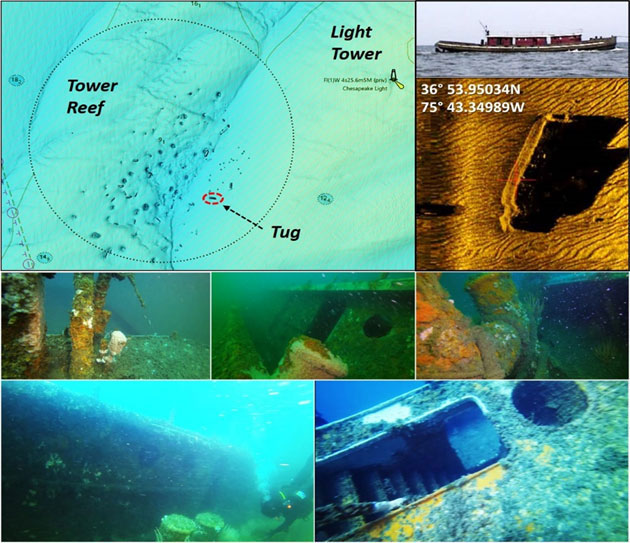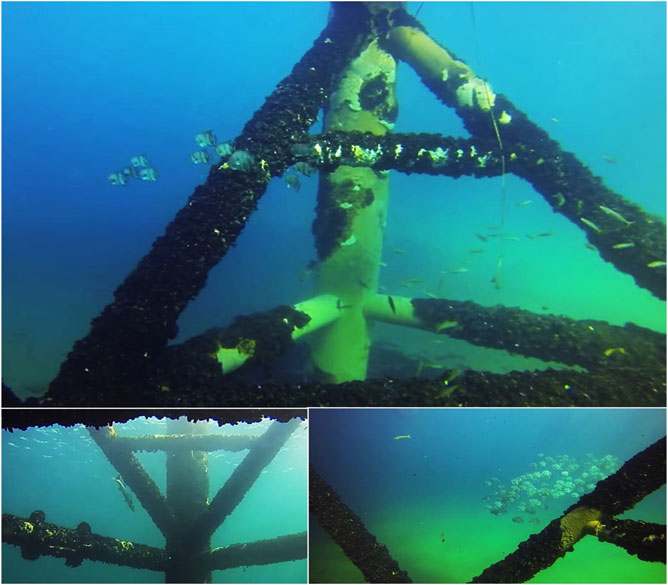Diver websites and YouTube videos are great resources for researching bottom structure that attracts sportfish and for assessing the performance of artificial reefs. Underwater photos and videos show the actual physical condition, extent of colonization by marine organisms, and types and species of fish present. Used in conjunction with sonar images as available, a more complete understanding of individual reefs emerges. With this in mind we’re taking another look at Tower Reef and also the Chesapeake Light Tower off the Chesapeake Bay entrance, this time through the photography and underwater videography of diver Jerrod K. Jenkins, JKJ Diving. (The full videos are posted on YouTube).

Tower Reef, located as it is in the Bay Entrance with depths in the 45’ to 65’ range, is in a high physical energy zone. Turbulence from storm waves reach all the way down to the bottom. So, it is not surprising that sonar images show scouring around individual structure. Scouring aside, how have the reef structures themselves fared overall? And, why has productivity fallen off at many of the subway car reefs? What we’ll find out is that the more robust features such as those consisting of obsolete ships and concrete structures have been the most durable, and offer excellent fishing opportunities. But, as revealed by Jerrod’s video and reports from other divers, the thin-skinned subway cars haven’t fared well. They’re much less fishing-friendly than when first deposited and have a short lifespan as fishing reefs.
An example of a robust structure is the tug J. B. Eskridge which was sunk as a fishing reef in 2002. The upper right images on Chart 1 are a Virginia Marine Resources Commission (VMRC) deployment photo and a side-scan image of the tug from a VMRC 2010 sonar report. Jerrod’s 2015 and 2018 underwater videos reveal the tug’s condition as a fishing reef. Still photos from the video show the wreck is intact, upright with about a 30-degree list, and heavily encrusted with marine organisms. Check this reef site for sea bass, and tautog, and also for flounder alongside.
The VMRC arranged for deployment of 50 Redbird subway cars at the Tower Reef in 2000. They were pushed off a barge by an excavator. Video taken during the 2018 dive disclosed that these cars have fared poorly in terms of durability. Although the visible remains were heavily encrusted with marine organisms, these light-skinned structures were literally torn apart. The remnants still provide marine habitat, but a small fraction of the original footprint. The remains also pose significant snagging hazards.
As an artificial reef manager some two decades ago, I would have jumped at the chance of getting a load of obsolete subway cars. On face value the cars offered by the New York subway system were excellent candidates for service as fish condos, and some 1300 of them were deposited at reef sites up and down the coast. But their demolished condition and missing metal components are representative of subway cars at other artificial reef sites from North Carolina to New York. Although the projected lifespan for the subway cars as fishing reefs was 25 to 30 years, what’s left today ranges from nothing to partial, thin vertical structures and scattered sheet metal.
After about a decade, corrosion of the rivet fasteners holding sheet metal to the ends and frames compromised structural integrity. This made the cars vulnerable to wave-generated energy and hastened their demise. A 10-year life span for an artificial reef isn’t very long. A better choice would be more durable structures at suitable locations to optimize the limited resources that are available for artificial reef development. Crushing prior to deployment and placement as stacked reefs in low physical energy locations might also be options for extending the lifespan, but would certainly increase preparation, staging, and deployments costs. The reef form would also be different than one with large voids.
Jerrod and companions dived on the nearby Chesapeake Light Tower in 2015. It’s a massive structure that was built in 1965 to replace the Coast Guard lightship formerly marking the Bay entrance. The 120’ high tower is supported by four 33” concrete-filled steel pilings that were driven deep into the seabed. The steel legs are tied together by massive crossmembers and corner supports below the surface. During the course of the spring through autumn fishing season the Tower draws large numbers of fish and is particularly well known for being a spadefish hotspot. However, expect to lose some end tackle when fishing close to the structure and bring plenty of spare gear.

The Tower Reef, Light Tower, and wrecks and obstructions around the lower end of the fish haven are a powerhouse combination as a sportfishing destination. However, the subway car remnants are a shell of their former selves. They may produce a few fish, but a better bet is looking for the tug, barge, and other more durable reef materials that were deployed within the fish haven. Expect to find a similar situation at other reef sites developed with the Redbird cars.
- By Wayne Young. As well as being a regular contributor to FishTalk, Wayne Young is the author of multiple books detailing wrecks and fishing reefs in the Chesapeake Bay, Delaware Bay, and beyond. All are available at Amazon.com, and you can find his Facebook page at “Chesapeake Bay Fishing Reefs.”